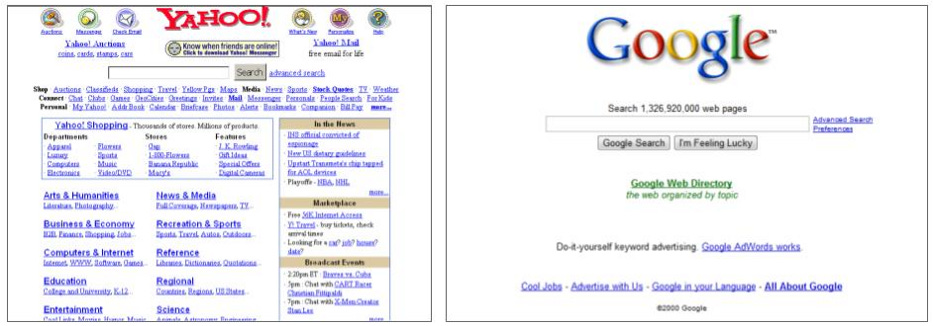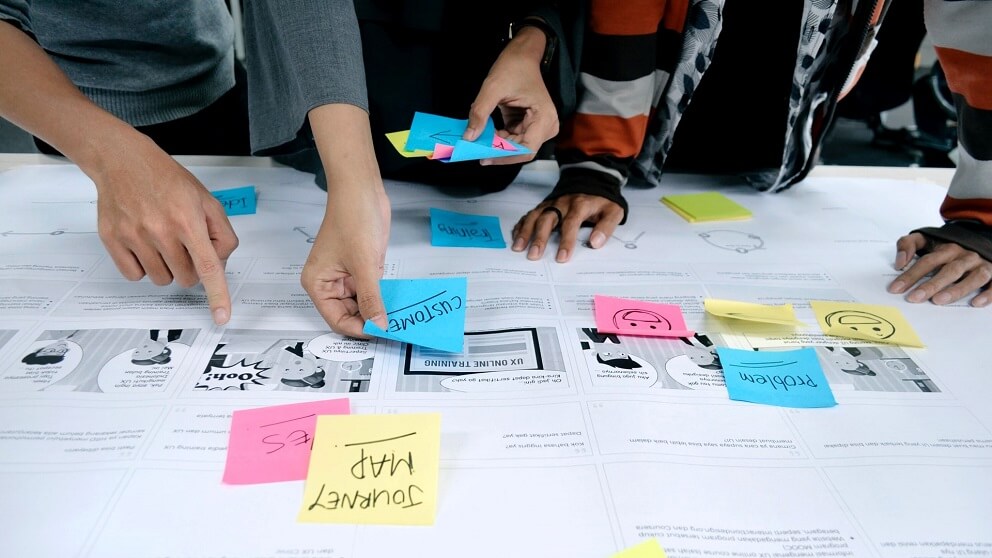Creating great customer experiences is not easy. Doing it consistently, over and over again, year after year is nearly impossible.
Yet, despite these odds….Google continues to build one great experience after another.
Here is how they do it
Google is obsessed about creating great user experiences
User experiences are a lot like first impressions.
You get one chance to get it right.
Do it well, and you create a customer for life. Do it poorly, and you might as well kiss that same customer goodbye.
Google understood this dynamic early on.
It’s, very first product — Search — was built on this philosophy.
Search was successful because of its unique user experience
In early 2000, both Google and Yahoo! were using the same underlying algorithm for search.
Yet the two user experiences were quite different.

With Yahoo, search was just one widget in a sea of other links. With so many decisions to make, it was easy for the user to get distracted.
Google on the other hand, focused on just one thing — Search. All the user had to do is type in their question. No other decisions to make.
By keeping things simple, Google made the experience frictionless.
The experience did not stop at the aesthetics, it went a lot deeper
Dig in a little bit deeper and you will see a ton of user experience innovation in the background.
For example,
- Innovations like autofill, spell check, and auto suggestion made it easier for users to adopt Google.
- Widgets like calculators, stock quotes, flight schedules etc., delivered answers directly to users. Saving them time.
- Displaying # of results and speed for every search built user confidence.
- And explaining why a user received certain results (strategic use of highlight and bold texts) built empathy and loyalty.
Today we take all of these innovations for granted. But when they were first released they were considered revolutionary.
It’s not just Search. This obsession is reflected in other Google products as well
Search is not the only product to benefit from great user experience.
Over the past 2 decades, Google has created 9 products that have over a billion monthly active users.
Each one delivering one great experience after another.
So how does Google consistently deliver great user experiences?
It comes down to three key ingredients.
- Experience First Mindset (Culture): Design principles on the importance of user design, it’s role in product development, and who’s responsible for it.
- High Performing Teams: Organization structure that is hyper focused on providing teams the best environment to create and innovate.
- User Centric Approach: A prescriptive process on how to create great experiences that users love.
Lets explore each ingredient, one at a time.
Ingredient #1: The Experience First Mindset is built into the DNA of the company
At Google it consists of the following three design principles
Experience Is Considered A Core Competency:
Since most users judge a product by it’s experience (it’s the tip of the iceberg). User experience is treated as a core competency in it’s own right.
It is not what the company does on the side. It “is” what the company does. And as such, it has its own budget, allocation of resources, and executive oversight.
Product Teams Focus On Experience First:
Uncovering the right experience is one of the first milestones in the product development lifecycle. Focusing on the user experience, forces the product team to get to know the user, their needs, and their goals.
What they learn here shapes the trajectory of both the product and the technology. It is never something that is “slapped on” after the product is built.
Product Managers Design Experiences (not UI developers):
At Google, experience design is never left to UI developers or outsourced to design shops. It is a core product manager’s responsibility.
Creating great experience requires — a deep understanding of the user’s needs and an intimate knowledge of the product. And no one is better suited to do so than the product manager.
Ingredient #2: Google’s organization structure creates the right conditions for High Performing Teams
Teams Own The Whole Product:
The team that builds the product is the same team that designs the experience. There are no separate product and experience teams. It’s just one team.
This allows teams to take a much more holistic view of the product (both experience and technology). It preserves continuity, improves communications, and allows for quick decision making.
Add to it the cross functional team makeup — each product team consists of (at a minimum) a product manager, user researcher, and engineer — and what you end up with an agile, independent, high performing team.
Management By Outcomes:
Team’s performance is evaluated based on their impact to the user and the business not on experience and features released (output).
Management sets the objectives and key results (OKRs), creates the right cross functional teams, and then pretty much gets out of the way. It’s up to the team to figure out how to meet the OKRs.
This provides the team a fair amount of autonomy but also the responsibility. A win win for both parties.
And if you are wondering, only 70% of the OKRs are met. And that is ok…it’s the price of innovation.
Investment In Continuous Improvement:
User tastes are constantly changing. To keep up with this, Google invests in upskilling both the teams and individuals.
To help teams improve their game, Google has an internal consulting group. The group’s mission is to coach teams, provide best practices (internal and external), and upgrade the product development lifecycle.
As for individuals, Google heavily invests in training, boot camps, and 1:1 coaching. Both new and practicing product managers are required to attend some form of training, so that they are constantly upping their game.
Ingredient #3: The User Centric Approach is where the magic happens
As to how Google is able to create one great experience after another, it comes down to a well refined process.
The product teams leverage the following 6 steps.
- Begin With The End In Mind: All experience projects start with defining success first (OKRs). No point working on an experience if there isn’t a well defined and measurable objective.
- Identify The Right User Problem To Solve: Good experiences solve user’s real problems. But what problem to solve? In this step, product teams understand the user, uncover their hidden goals / desires, and identify problems worth solving.
- Come Up With Big Ideas: If the experience is going to make an impact, the solution just can’t be a little bit better. It needs to be 10X better. The product team leverages several design thinking methods to come up with lots of big ideas.
- Validate Before Building: There is nothing worse than building the wrong experience. It puts the product in jeopardy, wastes time and money, and carries a huge opportunity cost. To reduce this risk, all product teams leverage prototypes to solicit feedback, iterate, and validate the solution.
- Build MVP: Even after validation, there is no guarantee that the experience will work with the broader user base. A better approach is to build small and continue to test.
- Measure Impact: Product team checks to see if the experience helped achieve the OKRs. Based on the data, the team decides weather to continue building or pivoting to a new solution.
Three things to note about the experience development process.
First, the steps are not linear. It’s not uncommon for the team to go back and forth between steps. The data they uncover in each step guides them on what to do.
Second, the overlap between the three ingredients is on purpose. For example, OKRs are embedded in mindset, team structure, and process. After all the goal is for each to support each other
Third, teams end up spending a fair amount of time in the design phase (steps 2, 3 and 4). Discovery is never straight forward, it’s full of false starts and dead ends.
But better to do it here, where it is cheaper. Then to build a product and later find out it was a complete waste of money.

